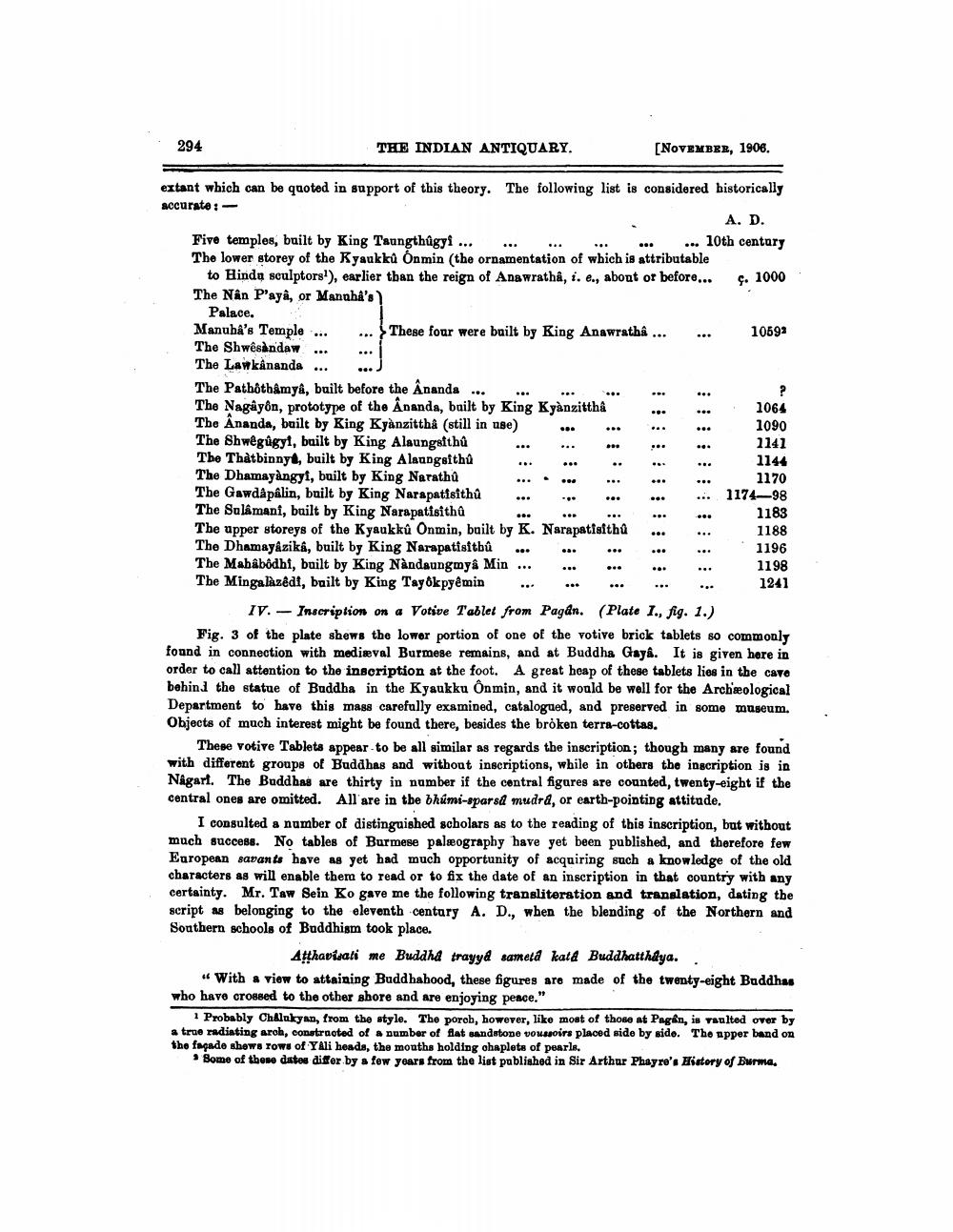________________
294
THE INDIAN ANTIQUARY.
[NOVEMBER, 1906.
extant which can be quoted in support of this theory. The following list is considered historically accurate : -
A. D. Five temples, built by King Taungthügyi ... ... ... ... ... ... 10th century The lower storey of the Kyaukků Onmin (the ornamentation of which is attributable
to Hindą sculptors'), earlier than the reign of Adawrathâ, i. e., about or before... ç. 1000 The Nân P'aya, or Manuha's
Palace. Manuba's Temple ... ... These four were built by King Anawratha ... ... 10692 The Shwêsànday ... The Lawkánanda ... The Pathothâmya, built before the Ananda ... The Nagâyon, prototype of the Ananda, built by King Kyanzittha
1064 The Ananda, built by King Kyanzitthå (still in nee)
1090 The Shwegügyi, built by King Alaungsfthủ
1141 The Thàtbinnyt, built by King Alaungsithu
1144 The Dhamayàngyi, built by King Narathú
1170 The Gawdâpâlin, built by King Narapatisithủ
1174498 The Sulêmani, built by King Narapatisithû
1183 The upper storeys of the Kyaukků Onmin, built by K. Narapatisfthu
1188 The Dhamayáziki, built by King Narapatisftbû ...
1196 The Mabibodhi, built by King Nàndaungmya Min ... ...
1198 The Mingalizedt, built by King Tayok pyemin ... ...
1241 IV. - Inscription on a Votive Tablet from Pagan. (Plate 1., fig. 1.) Fig. 3 of the plate shews the lower portion of one of the votive brick tablets so commonly found in connection with mediæval Burmese remains, and at Buddha Gaya. It is given here in order to call attention to the inscription at the foot. A great heap of these tablets lies in the cavo behind the statue of Buddha in the Kyaukku Önmin, and it would be well for the Archeological Department to have this mags carefully examined, catalogued, and preserved in some museum. Objects of much interest might be found there, besides the broken terra-cottas.
These votive Tablets appear to be all similar as regards the inscription; though many are found with different groups of Buddhas and without inscriptions, while in others the inscription is in Någart. The Buddhas are thirty in number if the central figures are counted, twenty-eight if the central ones are omitted. All are in the bhúmi-sparsd mudra, or earth-pointing attitude.
I consulted a number of distinguished scholars as to the reading of this inscription, but without much success. No tables of Burmese palæography have yet been published, and therefore few European savants have as yet had much opportunity of acquiring such a knowledge of the old characters as will enable them to read or to fix the date of an inscription in that country with any certainty. Mr. Taw Sein Ko gave me the following transliteration and translation, dating the script as belonging to the eleventh century A. D., when the blending of the Northern and Southern schools of Buddhism took place.
Atthavidali me Buddha trayya samet kald Buddhatthaya. · With a view to attaining Buddhahood, these figures are made of the twenty-eight Buddhas who have crossed to the other shore and are enjoying peace."
1 Probably Chalukyan, from the style. The porob, however, like most of those at Pagên, is vaulted over by a true radiating aroh, constrated of a number of flat sandstone voussoirs placed side by side. The upper band on the facade show8 rows of Y Ali heads, the mouths holding chaplets of pearls.
• Some of these datos distor by a fow yoars from the list published in Sir Arthur Phayro's History of Burma.




